Gehenna
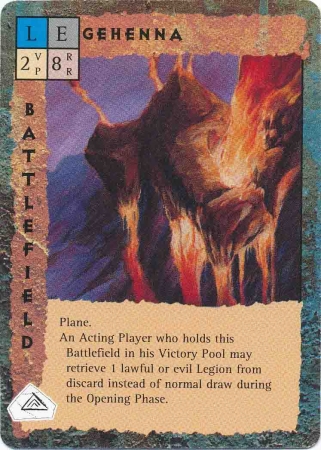
""Ye serpents, ye generation of vipers, how can ye escape the damnation
of Gehenna?"
(Matthew 23:33)
Gehenna

""Ye serpents, ye generation of vipers, how can ye escape the damnation
of Gehenna?"
(Matthew 23:33)
|
|
|
|
|
|
|
|
|
|
|
|
<image: YOU CAN LIVE FOREVER IN PARADISE ON EARTH, page 86>
The fourfold furnaces
of Gehenna are smoky, burning realms.
The ground provides light,
similar to the orbs of Tarterus, and
heat as well. Many realms will burn nonnative
creatures and
cause unprotected flammable items to burst
into flame.
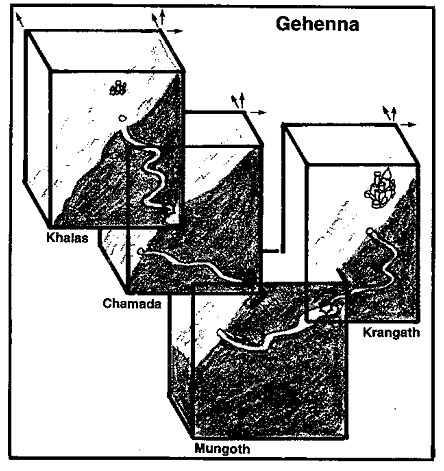
The layers of Gehenna
are mountains without bases or peaks,
and everything is built onto or carved
into the sides of these
mountains. The gravity is at a 45-degree
angle to the level of the <>
ground, so if a traveler loses his footing,
he could tumble for miles
down the slope before he can stop himself
(see WSG, page 36 for <link & update the WSG -- this section
may be missing>
tumbling down a moderate slope). If the
tumbling traveler strikes
a solid object (like the wall of a fortress)
while rolling down the
slopes of Gehenna, damage is suffered
as if hitting a level surface
in a normal fall (from a height equal
to the distance tumbled).
Gehenna's terrain varies from slippery
to slightly slippery
throughout its layers.
Gehenna's heat comes
from the ground itself. Vents, fumaroles,
and mud pots are common features. Lava
flows often ooze
down the flanks of the mountains. Eruptions
and earthquakes frequently
rip the land asunder. Those unprotected
from heat suffer
1d6 points of damage per turn, though
devices and spells that
negate the effects of the plane of Elemental
Fire work to prevent
damage from Gehenna's heat.
Gehenna has four layers, each having similar mountainous terrain.
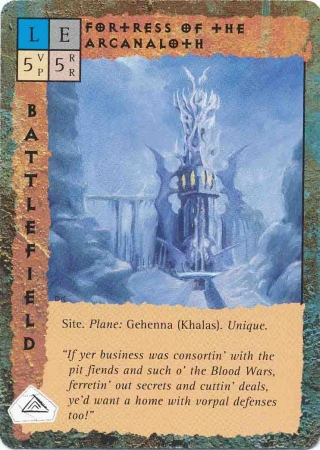
Khalas, the topmost layer (nearest
to the Astral), is the most
temperate of the layers of Gehenna. A
number of creatures and
minor Powers make their homes here, incl.
those devils
from Hell that are currently out of favor
or in hiding. The
light for this plane is provided by the
arching lava and fires of the
ground. The sky is reddish colored near
the horizon, but this
slowly fades to black toward the zenith.
The atmosphere continues
forever, but no traveler has ever found
anything within the
sky.
Khalas is also a region
of waterfalls that flow down its slopes,
swathed in steam that rises as the water
evaporates from the
heat of the ground. The largest cascades
are those of the Styx,
which follows a rough-hewn course down
the mountainside, falling
thousands of feet, twisting through rapids,
then passing into
the underground passages that lace Gehenna's
interior.
Chamada is the second layer. Its
terrain is more violent than
that of Khalas. Lava flows in cascades
thousands of miles wide
down the sides of the mountain. The mountainside
is full of erupting
volcanos wide enough to swallow whole
cities. The sky is
brighter near the horizon, but the air
within 10 miles of the surface
is filled with an acrid cloud that inflicts
blindness on those with
unprotected eyes. This cloud also acts
as a perma stinking cloud (those who
cannot escape this region can literally
spend the REST of their lives choking && coughing). The regions
beneath the surface of Chamada are free
of this stinging, horrible
cloud, but the smell of burning hair &&
flesh permeates even
these depths.
Mungoth is the third layer, a layer
of ash and burning snow. It
is a cold layer of Gehenna. While there
is continual volcanic activity,
its furnaces are fewer and farther apart.
Ice and snow are
common on the edges of the volcanic reaches.
The greatest
danger to travellers in this region is
avalanches of wet snow mixed
with burning rock. The sky of this layer
is darker, as there is less
volcanic activity to provide {light}.
The underground regions are as
comfortable as this layer ever gets.
Krangath is the final
layer; its name means "the dead furnaces."
Whatever fires existed here are long gone.
The sky and
surface are completely dark. There are
no sources of heat || {light}
even in the cavern complexes <complices?>
beneath the surface of this layer.
There are several ways
to reach the topmost layer of Gehenna.
The Styx flows through Khalas in its long
journey among the
lower planes. Khalas can also be be reached
from the Astral
(through color pools and viewing points)
and from the adjacent
planes of hte Nine Hells, Hades, and Concordant
Opposition.
Interplanar portals are always found deep
beneath the surface of
Gehenna. They appear to be black chasms
in the floor. There is
no formal method of identification, but
intelligent creatures usually
mark the walls to inform travellers of
the portal's destination.
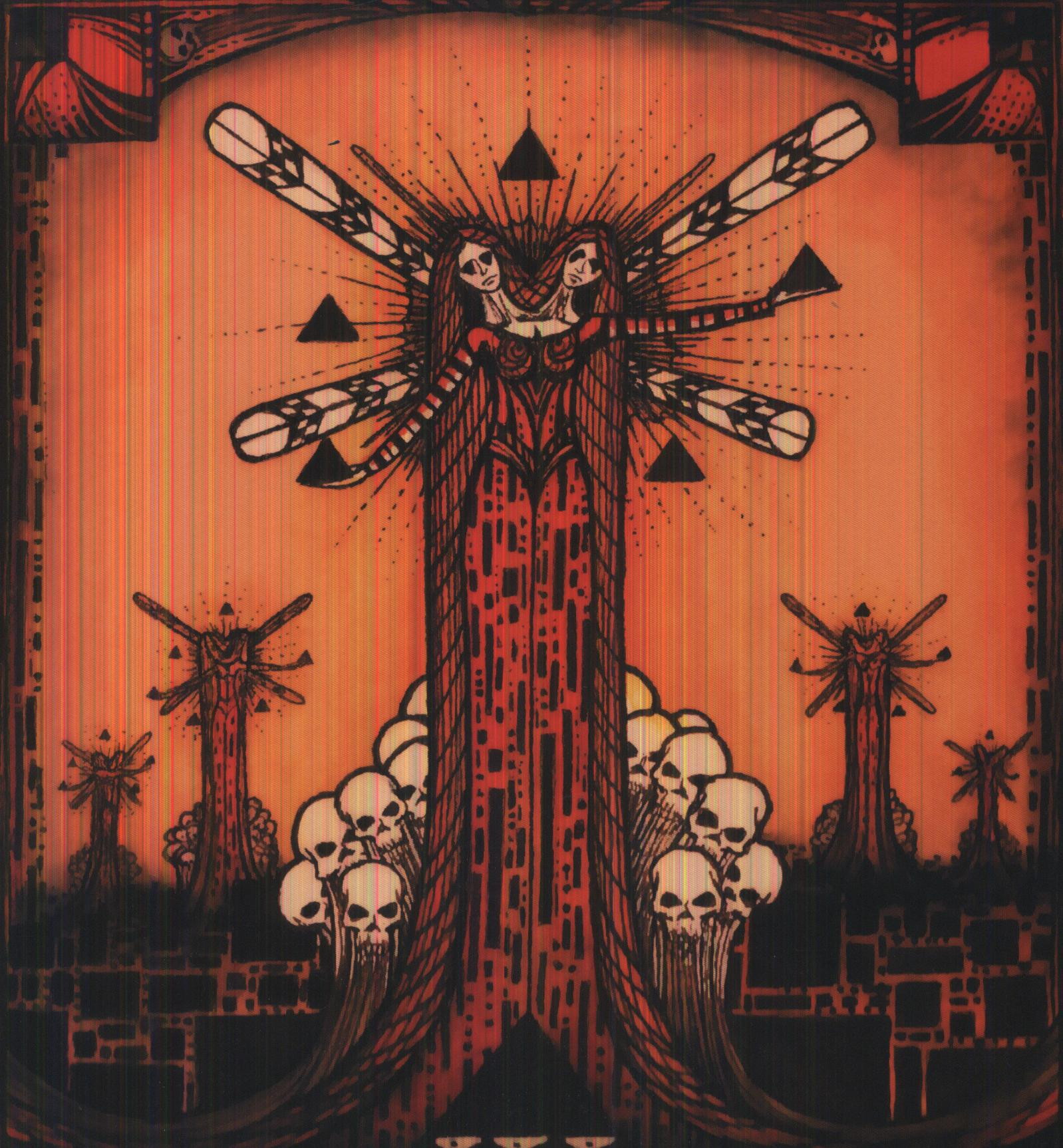
Similarly, the barriers
between the layers are always found
beneath the furnaces of the plane, usu.
(but not always) in
dead end corridors. The arrangement of
the barriers has led
some sages to consider Gehenna to be a
four-sized pyramid
(each layer being one side of the pyramid),
but this is only a supposition.
There is a 5% chance that any barrier
leading to a
deeper layer opens into a volcanic region
(if into the second or
third layer), or a sealed cavern without
other escape (if in the
fourth layer). Travellers should consider
the eventuality of such
occurences when wandering through Gehenna.
Features of Gehenna
Gehenna is overrun with
creatures from the adjacent lower planes:
nightmares, imps, manes, daemons, mephits,
lesser devils, and
achaierai. These beings sneek into the
nooks && crannies &&
caverns of this plane as a place to hide
from more powerful
beings elsewhere. Likewise, the arch-devils
and daemon masters
found on this plane are always less-powerful
types who are
usually in disfavor with the ruler of
an adjacent plane. Resources
and manpower are low in Gehenna, so extra-planar
rulers ofen
allow it to be a plane of exile.
The only true natives
of Gehenna are barghests. These creatures
swarm through great rifts in the uppermost
layer, but they
are also found in the other layers (though
in lesser numbers).
They live solitary lives, but seek to
enslave weaker beings to
forge small empires
and to launch attacks against rival
barghests. It is chiefly because of these
continual battles (and
the fact that barghests dread the idea
of the next generation taking
over their petty baronies) that young
barghests are raised on the
PMP.
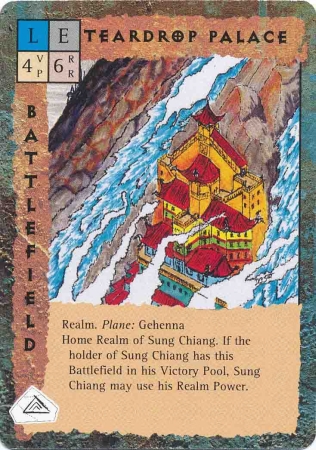
Few Deities reside in
Gehenna: those with a tendency toward
organization are quickly recruited into
the hierarchies of Hell,
while those who dislike Law tend toward
to gravitate toward the
grayer, more evil lands of Hades. Chih-Chiang
Fyu-Ya, a Chinese
Demi-God, inhabits a large
region of the first layer. His patience
is a great citadel shaped like a teardrop,
so that lava from above
passes to either side. Ath the highest
point of the citadel is the
demi-god's throne. He sits here and wathces
and waits to be
called to deal out judgment. A great temple
bell, carved from the
skull of a giant, hangs behind his throne.
When Chih-Chiang Fyu-Ya
is called, the tolling of the bell sounds
throughout the slopes of Gehenna.
Loviatar, the mistress
of pain in the Finnish pantheon, makes
her home in the third layer of Gehenna.
Her palace is a fortress
made of ice, protected by the mighty spells
of her parents, Tuonetar
&& Tuoni
(see Pandemonium) from the
occasional hot spots
in this realm.
She is served by faithful creatures that she rewards
with cruelty and abuse. Not a nice place
to visit.
Shargaas
of the orcs (UA) inhabits the depths beneath the
fourth layer of Gehenna. His followers
call this layer the Night
Land and Shargaas is the Night lord. All
the deep caverns
beneath Mungoth are controlled by this
Deity. Only Shargaas
and his spirit servants (taken from the
most evil of his people) can
see within his domain. If there
are planar barriers and deeper layers
to Gehenna, only Shargaas knows of them.
Quote:
Originally posted by
Grigori
Hey, Gary! An off the wall
question--- What, if any was the relationship between dreggals and barghests
in Gehenna? Barghests seem more powerful, but dreggals had the bigger role
in the Gord novels... Also, did you ever develop creatures native to the
Plane of Arcadia--seems that this plane in particular was neglected. Thanks!

Here I am again after thinking
I had slipped off this hook...
In developing some nasty
inhabitants for Gehenna, I figured that the dreggals would be the mnost
populos, not the mots powerful.
Thus you see lots of them
in action--the proverbial cannon fodder for the greater creatures behind
them.
They carry out the tasks
assigned, are expendable.
I never did get sround to creating a population for Arcadia, as that plane was not one that I envisioned as playing much of a role in the great struggle. Before that none of my players ever got sent to that place, so being a typically busy and harries DM, I didn't spend time working on something that seemed unlikely to be a factor in the campaign. Evenmtually I would have gotten around to it, mainly to toss something really different into the mix, but...
Cheers,
Gary
*template***template*